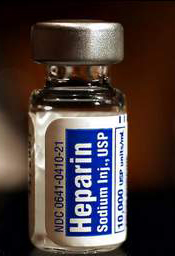
Two tests used to measure antibodies in patients with a history of heparin-induced thrombocytopenia (HIT) can produce radically different results, new research shows.
The anti-PF4/heparin IgG-specific enzyme-immunoassay can show that HIT antibody levels are high, while the functional platelet serotonin-release assay indicates that levels are low.
And researchers said the functional assay’s results may be the better indicator of a patient’s readiness for re-exposure to heparin.
Theodore Warkentin, MD, of McMaster University in Hamilton, Ontario, Canada, and his colleagues expressed this viewpoint and detailed the research supporting it in Blood.
When patients with a history of HIT require urgent heart surgery, physicians must test for the presence of HIT antibodies to determine whether the patient can be re-exposed to heparin during the procedure.
Hematologists use two types of tests to measure HIT antibodies—a functional platelet serotonin-release assay and an anti-PF4/heparin IgG-specific enzyme-immunoassay. If the more widely used immunoassay indicates the presence of HIT antibodies in a patient, surgery is usually delayed or plasma exchange is performed to lower the antibodies.
Practitioners have historically understood the two assays to provide similar conclusions, but a case report suggested otherwise.
A 76-year-old female with kidney cancer and previous HIT required urgent cardiac surgery to remove a tumor that had spread to her heart. After both her initial functional and immunoassays indicated the presence of HIT antibodies, her doctors deemed her ineligible for surgery.
But after repeated plasma exchange, the researchers performed both the functional and immunoassays on the patient again, and, this time, they observed strikingly different results.
“We were surprised to see that levels of HIT antibodies in this patient fell very quickly according to the functional assay, yet the antibodies detected by the immunoassay remained high,” Dr Warkentin said.
“This suggested to us that, while physicians in many situations may be waiting for the immunoassay to indicate lower antibody levels, patients in urgent need of heart surgery may be ready much earlier than the results suggest.”
To better understand the dissociation between the results of the two tests, Dr Warkentin’s team developed a model comparing functional and immunoassay results among 15 HIT blood samples. The samples were sequentially diluted and tested with both assays to mimic the effects of repeated plasma exchange.
The researchers observed that HIT antibody levels as measured by the functional assay decreased rather quickly, while the immunoassay continued to indicate high levels.
This suggests the sensitivity of the immunoassay may provide an overly conservative estimate of HIT antibody levels and their clinical relevance. The analysis illustrates how quickly platelet-activating properties can decline in a patient, either naturally or by using plasma exchange.
The observations also support the use of repeated plasma exchange as a therapeutic strategy prior to planned heparin re-exposure among patients with a recent HIT episode who require urgent cardiac surgery.
“Based on these findings, physicians should consider utilizing both of these tests when preparing a patient with a history of HIT for urgent heart surgery, considering the functional assay result as the stronger indicator of a patient’s readiness,” Dr Warkentin said.
“For these patients, [plasma exchange] can be a useful option to help rapidly reduce their remaining HIT antibody levels, minimize their risk of developing clots, and get them into the operating room sooner.”

